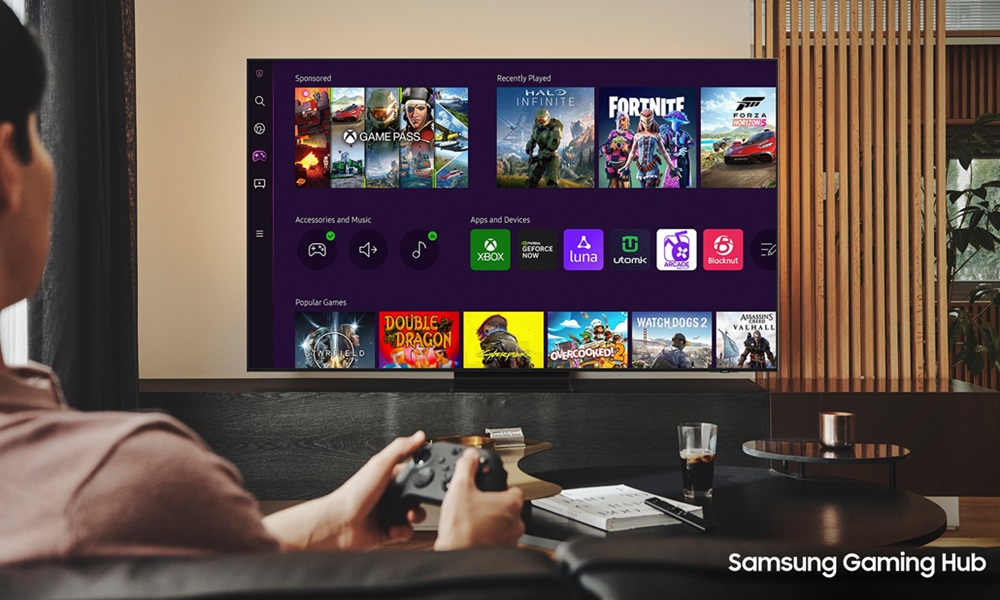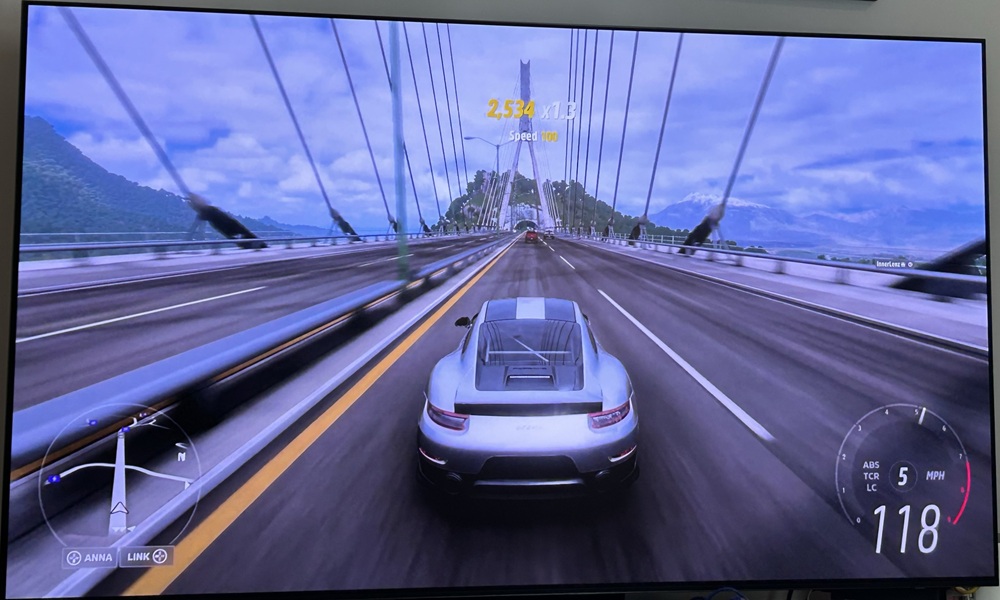A few months ago, I had the opportunity to review the absolutely beautiful Samsung S95D OLED TV. I painfully shipped it back after 30 days, but not before I immersed myself in the vibrant colors and deep blacks that this display technology offers. Most of my usage involved movies and TV shows that I knew to serve OLED’s capabilities well, but one other feature of the TV caught my attention: cloud gaming.
Via the Samsung Gaming Hub and partnerships with leading gaming providers like Xbox, NVIDIA GeForce Now, Amazon Luna, Boosteroid, Blacknut, and others, users can play some of the most popular titles in the gaming world on TVs, monitors, and projectors powered by Samsung’s Tizen OS.
My time with the S95D was short, but I was able to play games like “Forza Horizon 5,” “Red Dead Redemption 2,” “Microsoft Flight Simulator,” “Call of Duty,” and others right on the TV without having to fire up my aging Xbox One.
That was the first time I picked up a controller (the Xbox One controller was paired to the TV) in more than a year due to the birth of my daughter, but the Samsung Gaming Hub made it incredibly easy to switch from TVs and movies to gaming with just a few clicks of a remote.
That, according to Samsung’s Mike Lucero, is the main idea behind the service, which launched in 2022 as one of the first cloud gaming solutions available on a TV, and continues to be a focus for the company.
Samsung’s Strategy for Winning Over New and Existing Gamers

According to Lucero, I am what the industry refers to as a “lapsed gamer,” essentially someone who used to game but doesn’t anymore. That is, until I did on the Samsung TV thanks to the convenience and accessibility.
In short, Samsung is the leading maker of TVs, and these TVs are found in millions of homes all over the world. This gives Samsung and any willing gaming partner incredible access to capture a broad spectrum of gamers, from the avid, hardcore gamer to the casual gamer—and yes, the lapsed gamer who had a kid and doesn’t get to fire up the Xbox anymore or spend money on a new console without a spouse’s approval.
“We have sort of an underlying supposition that everybody is a player,” Lucero says. “We think there’s this fundamental human desire to interact with and play with things, so our ambition is to tap into all of that.”
The company was able to “win the hearts and minds” of core gamers with the quality of the product and hardware on which the platform runs, and it’s an interesting value proposition for gamers who don’t want to spend hundreds of dollars on a console, or potentially thousands on a gaming PC.
Samsung now builds their hardware with gaming in mind, offering things like 4K upscaling to enhance the quality of streamed games, low-latency Game Mode to reduce input lag and improve responsiveness, high refresh rate displays of up to 4K at 240Hz.
Gaming Without a Console

The whole idea behind Gaming Hub, Lucero says, is convenience and accessibility. Xbox users need a TV or monitor to play, but what if that TV or monitor can essentially double as an Xbox?
This can also help users save money on gaming hardware if their TV is already equipped with cloud gaming. Gaming consoles are growing more expensive with every generation, with the Xbox Series X, the most advanced version of the new-gen Xbox that launched in late 2020, still retailing for about $500 on some online stores. The PlayStation 5 is not far behind at around $450.
Gaming PCs can be found for under $500, but most gaming experts will scoff at the specs of that machine.
In addition, gaming on a TV without a console is just straight up convenient. Downloading new games to consoles can take hours, but streaming it directly to a Samsung TV takes a fraction of the time.
“We’re taking all sorts of friction out of the equation and just making it easier for you to get to do what you want to do, which is play the game,” Lucero says.
Also helping to grow adoption of cloud gaming is the availability of Gaming Hub on a range of Samsung screens, including the company’s Freestyle projector with Gaming Hub built in.
“If you would ever want a portable console, this is the best thing ever,” Lucero says. “It’s basically a console that’s the size of a can of Foster’s beer.”
Cross-Medium Immersion and Casual Games
The ability to switch between gaming and watching TV or movies in the same interface without having to switch the input also helps users consume whatever genre they’re into at that point in time. When I had the Samsung S95D in my home, I was finishing up my second playthrough of Red Dead Redemption 2, and I was absolutely immersed in the western genre.
After the game sadly ended, I could easily navigate the Tizen OS interface to streaming services to stay in the same world and watch “The Revenant” or “True Grit.” Similarly, users can play “Halo” titles and then watch the series of the same name on Paramount. This is not even mentioning the “Fallout” series of games and the Amazon TV series.
“When you see something again, you remember why you liked it. When you see a movie or TV show based on a game, you want to go back and play that OG version again because you remember it form when you were younger,” Lucero says. “Being able to have everything served up in a single place really drives more engagement across the board, which is obviously value for both the franchise holders and the viewers, because they get more of what they want.”

In addition to games on Xbox Game Pass and other popular cloud gaming services, Samsung and other gaming providers are offering more casual games for those who would rather play games with family and friends than spend hours on a campaign or battling other games in multiplayer modes. For those games, Samsung offers alternative input methods such as a virtual controller and standard TV remotes.
These options help reduce entry barriers for casual gamers and encourage greater adoption of cloud gaming, Lucero say, highlighting “Jackbox,” a provider of popular party games that was made available through Amazon Luna. The games don’t require a controller and allows players to use their phones, which removes a barrier for casual players.
“Jackbox” is also making its way to other smart TVs later this year thanks to a new cloud-powered app made possible through Amazon’s new GameLift Streams.
LG Lands Xbox for Cloud Gaming
While Samsung may be the most built-up offering in terms of being able to game on a screen sans console, there are a handful of other manufacturers doing similar things with their hardware.
Most notably, LG has launched Gaming Portal, that features a partnership with Xbox and similar gaming providers in Samsung’s offerings. LG says Gaming Portal is available on LG TVs running webOS 23 and above, but it will soon extend to additional platforms and devices like monitors and lifestyle screens.
LG didn’t answer request to comment for this article, but in a statement, Chris Jo, senior vice president of platform business at the LG Media Entertainment Solution Company, said in a statement that the Xbox partnership will bring a broader selection of popular games to LG TVs.
“The Gaming Portal will provide users with a seamless, convenient and exciting way to enhance the gaming experience on LG Smart TVs,” Jo said.
According to LG, Gaming Portal will be accessible right from the webOS home screen, much like Samsung’s Gaming Hub. The company says the service will provide an overview with an app list that includes cloud gaming apps, webOS app games playable with a remote controller, recently played games, and lists of popular games.
LG has offered cloud gaming in some form on certain smart TVs since at least 2021, and in addition to Xbox, now allows users to play games from NVIDIA GeForce NOW, Amazon Luna, Blacknut, Utomik, and Boosteriod.
The Xbox partnership and launch of Gaming Portal, however, is designed to elevate the experience and appears to be LG’s response to Samsung’s growth in the gaming category.
Other Ways to Game on a TV Without a Console or PC
Amazon is another company that recently brought Xbox games to its home entertainment offering, bringing the Xbox app to newer models of its Fire TV Stick and Fire TV Cube devices for Xbox Game Pass Ultimate subscribers. According to Amazon, compatible devices include the Fire TV Stick 4K Max (2023), Fire TV Stick 4K (2023), Fire TV Stick 4K Max (1st Gen), or a Fire TV Cube (3rd Gen).
In addition, gamers can also play games on Amazon’s Luna game streaming service on Fire TV devices, including Amazon’s own manufactured TV sets. Notably, however, the Xbox partnership does not include the ability to game on Amazon Fire TVs, only streaming media devices.
Apple TV, probably the streaming device most used in the custom home technology industry, does offer some gaming experiences, but more popular games from Xbox and the other services mentioned in this article aren’t directly available on Apple TV devices. Instead, the device allows for playing games streamed from other devices, including Xbox and PlayStation
What is available, however, is the Apple Arcade, which Appel calls “a game subscription service that offers unlimited access to a growing collection of over 200 premium games — featuring new releases, award winners, and beloved favorites from the App Store, all without ads or in-app purchases.”
However, these aren’t the massive, popular games like Call of Duty or Fallout available on other services. Instead, they are smaller arcade-style games.
Cloud Gaming’s Growth Potential
The list of screen manufacturers that are building cloud gaming into their hardware will likely grow. There are a handful of other TV operating systems and devices that do support cloud gaming in some form, but the cloud gaming industry is pretty young, and availability is quite fragmented. In some cases, users can download certain gaming apps on devices, but lacking official support, the experience is not great, according to online reviewers.
Cloud gaming on smart TVs is still just a handful of years old, and the industry is still trying to win over core gamers with cloud gaming. Samsung didn’t divulge any specific numbers on its Gaming Hub growth, but Lucero did say that Gaming Hub user have nearly doubled since December 2023.
Samsung is testing interactive gaming elements within TV advertising, referred to as “Game Breaks.” This feature inserts short, interactive games into ad spaces, allowing brands to engage viewers in a more dynamic way.
When asked where custom home integrators fit into this market, Lucero first mentioned that the quality of the stream is critical, which reinforces the importance and reaffirms the growth of enterprise-grade home networking solutions.
Integrators also have the opportunity to enhance the gaming experience with immersive audio and lighting.
“It’s about the full experience: the rich audio, the rich coloring and the refresh rates of the screens,” Lucero says. “It all comes together.”
Gaming can be one of the most visceral, immersive, and engaging mediums of entertainment, and the custom home integration industry is well-suited to provide those elevated experiences by leveraging the technology that is already built into the systems they’re installing.
“We just want to make sure people can play and have fun on their TVs,” Lucero says.

















